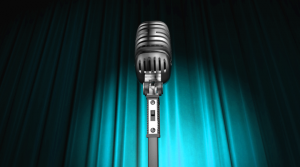Going video online is not an easy feat. You will not like your voice, you will not like the way you look and you may not like at all what image you project. Here’s a quick video about my personal experience and about the 3 things that matter when you go video.
Archives de catégorie : Public Speaking
Quand le corps parle…
Parler en public ne se résume pas à « parler » en public, mais à utiliser toutes ses facultés corporelles pour transmettre le message que vous souhaitez. La voix commence par une bonne respiration et une bonne position du corps.
J’ai eu l’honneur de préparer et donner une masterclass sur le « body language » pour mon club Toastmasters. En voici les diapos powerpoint pour faire patienter avant une formation en ligne.
Fondée sur mon livre Parler et faire une présentation en public en toute confiance, cette formation l’approfondit par des exercices le rôle du corps dans la communication. Respirer, se tenir droit et bouger pour une communication amplifiée, plus efficace et moins stressante.
Tout commentaire est le bienvenu.
Crédit photo Robert Collins sur Unsplash
Parler et faire une présentation en public en toute confiance – Le livre !
Et voilà, le vingt-et-unième (peut-être vingt-deux, il faudra que je recompte) bébé est né cette semaine chez ENI Editions.

Il est disponible en ligne sur le site de ENI Editions (en version électronique ou papier), sur Amazon (en version papier uniquement), et dans toutes les bonnes librairies. 21,95 Euros pour devenir un(e) orateur(trice) hors pair. Des années d’expérience compactée dans 250 pages. J’ai pris un immense plaisir à l’écrire, j’espère que vous prendrez un immense plaisir à le lire.
Je vais organiser dans les semaines qui viennent une petite tournée de promo sur Maurice et Réunion, et pourquoi pas en Gaule, mais j’y reviendrais… Je suis très occupé en ce moment par mon prochain bébé, un monumental ouvrage sur l’intelligence artificielle et les services cognitifs d’AWS (rien que le sujet fait peur, mais n’ayez crainte, ça va être un gentil monstre).
En attendant de pouvoir dédicacer ce nouveau livre à qui croisera mon chemin dans les jours qui viennent, je vous souhaite une excellente lecture. Voici la table des matières pour vous mettre en appétit (en téléchargement ici)
Introduction
Tout le monde peut parler et briller
A. Introduction
B. Art ou science
C. Parler c’est quoi ?
D. Un peu de technique
E. Le seul conseil à suivre
Quel outil pour quel message et quelle audience ?
A. Introduction
B. Logiciels, matériels et accessoires
C. Les différents types d’outils
D. Logiciels propriétaires ou gratuits, de présentation ou pas…
E. Microsoft, Apple, Google
F. Prezi, Sway, Canva
G. PDFs, Evernote, OneNote
H. Tous les autres
I. Comment choisir
Construire son message – Vous en avez plus à partager que ce que vous croyez
A. Introduction
B. Qu’avez-vous d’unique ?
C. Jeter ses idées mode storyboard/mindmapping
D. Trier, couper, arranger – Se centrer autour de l’idée-force que vous voulez que votre auditoire retienne
E. Une présentation, c’est comme un film d’Hollywood
F. Utiliser les « cliffhangers »
G. Utiliser les fonctionnalités du logiciel à votre avantage (sans les utiliser toutes)
H. L’histoire ne fait pas tout, c’est vous qui faites l’histoire
I. Pensez aussi au support papier/électronique
J. La révision, l’ordre et le contenu des diapositives
Devant l’ordinateur, il y a vous : respirez !
A. Introduction
B. Respiration
C. Le corps en résonance
D. La projection du son
E. La voix
Cent fois sur le métier… – Répéter et finaliser votre présentation
A. Introduction
B. Quoi
C. Avec
D. Où
E. Quand
F. Profiter des répétitions pour transformer votre présentation en vidéo YouTube !
G. Pourquoi
Sauter comme Van Halen et débriefer pour progresser !
A. Introduction
B. On n’apprend pas à faire du vélo dans un livre
C. Où se mettre ?
D. Utiliser l’audience
E. Savoir terminer sa présentation
F. La psychologie de l’échec
G. Impossible de plaire à tout le monde
H. L’analyse post-mortem
Conclusion
A. L’histoire sans fin
B. Les avantages de parler en public
C. Et pour finir …
Si la peur de parler en public vous paralyse, la solution, c’est Parler et faire une présentation en public en toute confiance ! Faites-vous un cadeau utile. Bonne lecture !
Contrat signé pour un nouveau livre
J’ai signé il y a quelques jours un nouveau contrat avec les éditions ENI pour un livre dont le sujet est Comment faire une excellente présentation et parler en public en toute confiance. Le titre final n’est pas encore défini, la table des matières oui en revanche et les 40 premières pages écrites.
A destination de toutes les personnes qui ont besoin de s’exprimer en public, il se focalise sur comment améliorer sa voix et ses présentations, en s’appuyant sur les outils de présentations disponibles du le marché, de PowerPoint à Canva en passant par Prezi et Sway.
Présenter et parler en public est la rencontre de l’art et de la science. Que vous soyez débutant ou présentateur aguerri, mon objectif est de vous apprendre quelque chose et de vous faire devenir encore meilleur. 30 ans d’expérience condensés en quelques centaines de pages. En avant première, deux paragraphes de l’introduction qui vous donneront un aperçu du ton et du contenu.
» « On naît orateur » est une phrase destructrice. Elle sous-entend que si vous ne savez pas parler en public, vous ne le saurez jamais. Heureusement, la science nous a appris que toute aptitude s’acquiert. Dans son remarquable ouvrage, Changer d’état d’esprit : une psychologie de la réussite, Carol Dweck, son auteure, nous apprend qu’en changeant d’état d’esprit, il est tout à fait possible d’acquérir toutes les compétences possibles à ses rêves et que rien n’est prédestiné. L’épigénétique et la plasticité cérébrale ne font, depuis, que renforcer nos connaissances de notre adaptation à l’environnement et à ce que nous voulons être.
Parler en public fait donc partie de ces compétences qui s’acquièrent. Bien évidemment, ne devient pas orateur qui veut en quinze jours. Cela demande de la méthode, du travail et des efforts. Démosthène, grand orateur Grec de l’antiquité, était bègue. Georges VI, roi d’Angleterre de 1936 à 1952 et père d’Elizabeth II, était lui aussi bègue. Ces deux grands hommes surmontèrent ce handicap, l’un en s’entrainant à parler avec des cailloux dans la bouche nous dit la légende, l’autre à force de travail avec son orthophoniste australien Lionel Logue. Si ces bègues ont réussi à surmonter cette déficience et à devenir des orateurs brillants, tout un chacun peut y arriver. »
je publierai d’autres extraits avant correction sur ce blog au fil de l’écriture pour vous donner envie de lire le livre final. Publication prévu au printemps prochain! En attendant, je ne peux que vous conseiller de lire mon livre précédent, Cloud privé, hybride et public.

Crédit photo Xan Griffin sur Unsplash
How to kick the fear of public speaking in the b…
 It is said that on the fear list, public speaking comes before the fear of death. It has even its own word: glossophobia, coming from the Greek glossa, meaning tongue, and phobos, meaning fear. The symptoms of glossophobia can vary and are numerous: dry mouth, trembling body, sweating, just to name a few. In her article How I Got Over My Fear of Public Speaking, Kelly offers a good set of advices, from her own experience, on how to overcome glossophobia. I although introduced 3 simple hacks to better speak in public and 5 deadly mistakes to avoid to be a good speaker.
It is said that on the fear list, public speaking comes before the fear of death. It has even its own word: glossophobia, coming from the Greek glossa, meaning tongue, and phobos, meaning fear. The symptoms of glossophobia can vary and are numerous: dry mouth, trembling body, sweating, just to name a few. In her article How I Got Over My Fear of Public Speaking, Kelly offers a good set of advices, from her own experience, on how to overcome glossophobia. I although introduced 3 simple hacks to better speak in public and 5 deadly mistakes to avoid to be a good speaker.
Whatever your audience, whatever your topic, and whatever your public speaking skills, anxiety and fear always kicks in. There’s a story one of my mentors of public speaking that I particularly like: A young actress, after a play, goes to see the great Sarah Bernhardt and asks « madam, I never add stage frights, is this normal? » Sarah Bernard answers « Don’t worry, it comes with talent ». Just to say it’s completely normal to have stage fright, it’s actually a nice feedback loop that helps us remember the essential things to do to get good at what we are about to do.
Here are a set of behavioral tips and tricks to feel better when you are about to deliver a public speech:
- Shout! If you can find a secluded place when nobody hears you, go there and shout the loudest you can. It will help a lot empty the tension you have.
- Stand right! Pull your shoulders backwards, push your breast forward and stand right. Exaggerate the movement before setting the foot on stage, it will relieve the tension in your upper body.
- Put one foot slightly ahead of the other! A little bit like martial art practitioners. This will provide a better balance.
- Breathe slowly and deeply! Breathing is essential, breathing slowly will lower your cardiac speed and lower your anxiety
- Look at your audience, spotting friendly faces! There are always friendly and smiling faces in an audience, look at them like you were speaking to them one on one, but do not speak only to them, move your eyes around, and come back to those friendly faces.
- Accept mistakes and failures! You tongue will trip. You will forget a sentence or a paragraph. All this, and more, happens, even to the best. The only way to avoid this is to rehearse, rehearse, and rehearse. If you do not have the time, accept little mistakes
One thing that most people do not realize is that the best speakers, the Obamas, the Jobs, etc. are prepared to the max. They have a prompter, they have coaches, and they have rehearsed dozens of time. There’s no shortcut to being a great public speaker, but the above simple tricks will help you getting better and better.
All the best!
The power of emotions
Day 645. Why is storytelling so powerful? Because of emotions. There’s no other way to get decisions fast without emotions. In business, emotions have been banished for a long time. Business decisions are said to be made on hard and cold facts. While it’s somehow true, we all know we can tell any story on any number. Look at who politicians are telling different stories on the same numbers depending they are part of the ruling party or of opposition.
For most people it’s the story that matters. Not the story itself, but the story and the storytelling. How you tell the story is crucial because you will derive emotions from it and emotions will drive decisions. Emotions play on specific part of the brain, generate specific neurotransmitters and influence decision. If emotions were outside of any decision process, marketing would not exist. That’s marketing that drives a part of the sales, the projection you make in your mind, the story it helps you tell yourself. Emotions and stories are intertwined. This is the power or stories, and the power of emotions.
When a startup founder pitches to a VC, it’s a well-known fact that the story matters more that the numbers that are merely « hope-casting ». When a salesperson pitches to a customer, the story matters about why and how the customer will benefit from the usage of the services or product sold. Remember the last time you got a raise, a promotion or made a successful sales. How did you feel? Good? You thought you were the king of the world? Next time, paint that picture to your customer. People do not purchase services or goods for their benefits, but for the experience they will have, for the emotions they will feel. This is how powerful emotions are. Hundreds of thousands of years of evolution have cables any human being like this. Find your customer’s motivation and the sale is made. Selling with emotions is the most powerful sales technique, less taught though!
Laugh, cry, or rant, emotions are the fuel of any human being!
5 common mistakes to avoid to be an accomplished public speaker
Day 616. I’ve been attending presentations yesterday from 8AM until 7PM, with more than 15 different speakers. All of them (but two, and I will tell you who later) did at least one of the below mistakes. By doing them, they diluted their message, minimized their impact and reduce the retention of the key points they presented. It’s sad because public speaking is not rocket science, anybody can become an accomplished speaker, and if you avoid those 5 deadly mistakes, you will have the impact that less than 5% of public speakers have. Let’s go:
- Speak to the screen behind you. I wrote a rant on this a couple of weeks. Screens do not hear you, your audience does. Never, never, never speak to the screen behind you. Either you have a monitor (or a prompter) in front of you that shows you what’s projected (this is your crutch) or you know your script. But please, speak to your audience.
- Read what’s on the slides that are projected. Any audience can read. If you read, you do not need to present, just show the slide and shut up. Better, send the slides to the participants, they can read them sitting on a couch or wherever they want. Slides with more than 5 lines of text and 8 words by line are bad slides. You may disagree with the numbers I am giving, I just put them here, I could have used 4, 7, or 6, 10, it’s just to say that less is more, actually it introduces the next mistake.
- Give facts, only facts. Slides or not slides, empty slides or full slides, facts are boring. If you need to provide facts, send me a document with the facts and the numbers, I can read it sitting on a couch, drinking coffee. Come on! If you want your audience to remember something, you need emotions, and you can provoke emotions only by telling stories. I always remember my area VP telling us during one of our mid-year reviews: « I can read, so don’t waste my time paraphrasing what’s on the slide (and those are not slides, but full pages written in font size 10 with tons of facts), tell me the story behind the facts » Even at that level of business, the story is more important than the facts.
- Speak in the dark. If I come to listen to you, I want to see you. You may have a wonderful setup, but if the scene is not correctly lit, you lose 50% of your impact. People cannot read your body language! A theater scene is not lit so you cannot see your audience (if you never set a foot on a theater scene, imagine the lights are so powerful, you cannot see the audience at all), they are lit so that your audience can see you. The side effect of this lighting is you cannot see the audience. A little bit lit the headlight of a car: you see what’s in front of your light, but if a car comes from the opposite direction and has its headlights turned on, you cannot see behind the lights.
- Go without rehearsing. If you read what’s on the slide because you are discovering the slide while projecting them, do not insult your audience by coming on stage. Go back to where you come from and come back when you will be prepared to tell me a story that will make me dream and wanting to act.
Public speaking is an art! Like all form of arts, it require training, rehearsing and « acting ». Acting means a lot of things, from the words you are using, to how to tell those words and to where to tell them. It’s not rocket science. Respect your audience! You may not have the time (or do not want to invest the time) to become a professional public speaker, but at least do not insult your audience by coming unprepared.
You want to know who were the 2 speakers who all respected the above points: a lawyer and an HR director. Lawyers are trained speakers and HR director’s job is to respect their people (at least good ones), no surprise they knew how to have a real impact.
Hey, hey, I’m here! Speak to me!
Day 604. We all know that when you deliver a speech, you need to speak to the audience. Actually, your audience is generally here to listen to you. Interestingly enough, if you were to speak to a friend, you would probably naturally look at him or her while speaking. Then, why on earth when a lot of speakers deliver a public presentation they look at one or two people, or worse at the screen behind them?
To enhance your public speaking skills, here are two simple tricks to ensure you speak to your audience, all your audience:
- Pick one or two nice faces in the audience and spend some more time looking at them to get comfortable. Your aim is to look at each people in the audience at least once. Try it, it’s fun! However, as some faces will not inspire you for whatever reasons, go back frequently to the ones you pick as your anchors.
- If you need to read your slides, look at your computer screen, never at the screen behind you. The computer! Not the projected screen! Yes, this means the computer needs to be in front of you. Every presentation software can duplicate the screen. PowerPoint even has a presenter mode that displays the note and the next slide. Remember, the screen is behind, the audience in front. Speak in front!
Yes, I know, some of you will say, yes, I know this! But next time, check if you looked at the screen behind or if you did get eye contact with every person in the audience. I bet yes and no, respectively. This requires conscious feedback and decision to look at the audience and not at the screen behind. It may become a second nature, but only with training. Enjoy!
The most important leadership skill…
Day 560. How do you become a respected and successful leader? As Lao Tzu wrote: When the best leader’s work is done the people say, ‘We did it ourselves.’ Hundreds of books have been written on leadership. Over the ages, leadership has changed and the necessary skills to be considered a good leader have changed too. However, all good leaders have one thing in common: they succeed through others. All good leader need others to deliver the vision. And to be able to lead others, they need one crucial skill and that is: speaking.
We all learn to speak by listening first, then by learning the rules, mostly grammar. However, what is barely taught is the how and the what (the content, not the rules). Words can lift you up, can tear you down, and can even kill. How you deliver those words can be the amplifier. Words and their delivery, a.k.a. speaking, is the most important skill of all because this is one you cannot delegate. You have to learn it, you have to rehearse, and you have to master it. The good news is it can be taught. Clubs like Toastmasters will equip you with the right skill set to speak and to lead.
Speaking is not difficult but it’s powerful. It requires understanding of its power and a lot of training. Once you master the art of speaking, you need to polish it, slowly, skillfully. The best investment you can do for yourself and for others!
The art of public speaking in 3 easy hacks
Day 555. Public speaking is said to said to be feared more than death. It’s so feared that it has its own word: glossophobia. If public speaking scares you, the best advice I can give is to join an organization as Toastmasters international or take courses to overcome this anxiety and help you deliver confidently speeches. However, over the years, with training and experience (nothing replaces experience in that matter), I came with three easy and simple hacks to overcome fear of public speaking. They do not require a PhD to understand or to apply. It’s jolly effective though! Here they are:
- Write and rehearse. At the exception of impromptu speeches, all prepared speeches need to be written in extenso. From the first to the last word. Not that you will be reading your speech, but writing is the first killer of anxiety. The second killer is to rehearse, rehearse, and when you are over, rehearse again. For a national contest, I repeat a minimum fifty times (yes fifty, five zero) my speech. I will know it by heart, but will rarely deliver the same words. It just anchors the flow and the ideas. Even the best actors rehearse, so should you!
- Breathe. Breathing is essential to speaking. Because while speaking you exhale, you need to inhale. Focus on your breathing. I actually do a dozens of deep breathing before stepping on stage. Not only it will calm you down, it will add extra oxygen in your blood that can get you a little bit dizzy, this will contribute to getting relaxed.
- Speak slowly. Let me tell you that everybody speaks too fast! If you think you are going too slow, record and listen. There is a big chance you will find you still speak too fast. You need to slow down from the beginning to allow you to breathe, to articulate, and to pause. If you speak slowly, you can accelerate to emphasize some dramatic pieces. There is a difference between pace and tone. You can have a joyful tone while going slowly. Do not fall in the trap of becoming monotonous, but allow yourself to slow down.
Of course, this addresses only the delivery of any public speech and not its content. The content will require another post, but you will find in this article from inc.com, 20 great advices, as well as 20 TED and TEDx videos to see different styles and effectiveness. I want to live you with one simple thought: stage fright is normal. Everybody has it! The day it disappears is the day you are becoming complacent and do not grow anymore. Do not be scared by stage fright, welcome it! It’s the signal that what you’re about to do matters to you! Just go and plunge!










